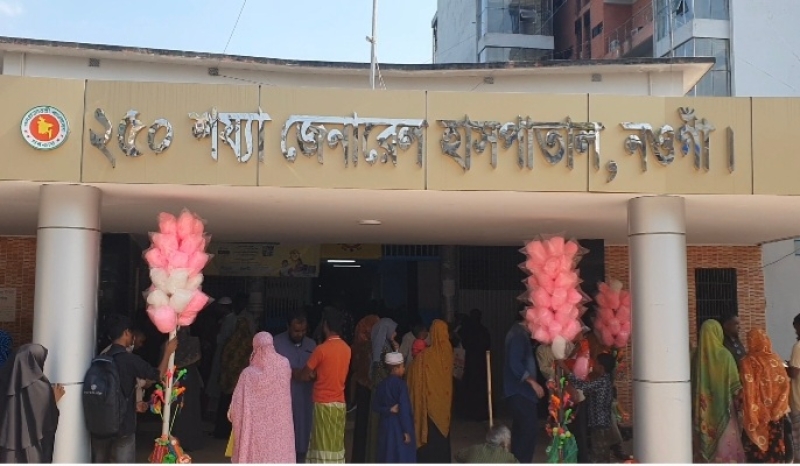- Cracks appear at newly built Secretariat building after quake |
- Dhaka’s air quality 4th worst in the world Tuesday morning |
- Bangladesh Bank extends loan rescheduling facility for defaulters |
- Divided journos end up serving politicians: Mirza Fakhrul |
- Naogaon residents battle dengue surge as urban services falter |
Naogaon residents battle dengue surge as urban services falter

People crowd Naogaon 250-bed hospital for dengue treaatment. UNB
In Naogaon municipality, the relentless rise of dengue cases is exposing a deeper public health crisis, as residents confront swarms of mosquitoes amid longstanding urban sanitation failures.
For weeks, communities across the town have battled insects invading homes, schools, businesses and offices—pestering residents even in daylight hours. Coils, sprays and smoke have become everyday essentials, yet the relentless buzzing and painful bites continue.
Locals said what was once a seasonal nuisance has transformed into a source of fear, frustration and growing anger at local authorities.
A Town on Edge
Naogaon Municipality, home to over 268,000 people across nine wards, is facing what locals describe as a preventable mosquito explosion. Open heaps of uncollected garbage, uncovered and clogged drains, and stagnant water turning neighbourhoods into breeding grounds have compounded the crisis.
“We close our doors and windows before evening, but it’s useless. Mosquitoes fly over burning coils. Their bites cause swelling and a burning sensation. I spend at least Tk 10 a day on coils, but if this continues, dengue is unavoidable,” said Shamim Ahmed, a resident of Masterpara.
Students are among the hardest hit. “Studying has become nearly impossible. I have to sit inside a mosquito net with a coil burning. This is no way to study,” said Arif Hossain from the Degree Mor area.
Tax Increasing, Services Declining
Residents complain that despite yearly hikes in municipal taxes, improvements in mosquito-control efforts are barely visible. Many allege that fogging and spraying target administrative or high-profile areas, leaving densely populated neighbourhoods neglected.
“There’s a municipal waste dump near my house. Mosquito-control activities here are rare. We pay higher taxes every year, but receive no proper services,” said Asfaq Uddin of Komaigari.
Health Risks Growing
According to the Naogaon Civil Surgeon’s Office, 56 new dengue cases were reported as of November 23. October saw 120 cases and September 116, bringing the district’s total infections this year to 321.
At Naogaon 250-bed General Hospital, 120 dengue patients were treated over the last three months. “No deaths have occurred so far, and we are providing adequate treatment,” said hospital statistician Dilruba Sultana.
Nationwide, the situation remains concerning. The DGHS reported two more dengue deaths on Monday, pushing the national toll to 366. With 705 new cases on the same day, the total infections reached 90,969 this year.
Local Authorities Admit Limitations
Naogaon Municipality Engineer Sajjad Hossain acknowledged the challenges, noting that the municipality has only three fogging machines and three hand-spray units.
“For the past two years, we haven’t received dedicated funds for mosquito control. We are running operations using municipal revenue and prioritising hand spraying, as it destroys larvae more effectively,” he said.
Health Officials Urge Vigilance
Civil Surgeon Dr Md Aminul Islam warned residents not to take fever lightly. “Any fever should be treated seriously. People must seek medical care immediately and not stay at home ignoring symptoms,” he said, stressing the need for collective awareness.
A Crisis Demanding Answers
For Naogaon’s residents, the mosquito menace is more than an inconvenience—it is a daily struggle affecting education, livelihoods, and mental well-being. As dengue infections surge nationwide, their frustration underscores deeper issues: inconsistent municipal services, fragile waste management, and the absence of sustained vector control.
Until these systemic problems are addressed, the people of Naogaon fear they will continue paying the price. -UNB

